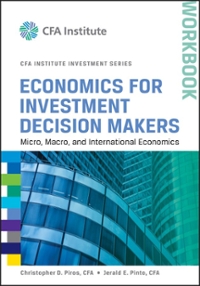Question
Pavonia Case Scenario (30 points) Pavonia LDI Consultants offers asset management and advisory services to small firms with defined benefit plans and to individuals planning
- Pavonia Case Scenario (30 points)
Pavonia LDI Consultants offers asset management and advisory services to small firms with defined benefit plans and to individuals planning for retirement.
At the beginning of 2019, Whitney Adams, senior adviser, meets with her new client, Donald Berendsen, in order to review the fixed-income portion of his retirement portfolio. Berendsen, who plans to retire in four years, intends to use this part of the portfolio to supplement income he will be receiving from Social Security, a US government retirement income program.
Berendsen explains to Adams, I plan to continue saving for retirement, regularly adding funds to the portfolio until I retire, and I would like a low-risk solution to provide additional retirement income.
Adams replies to Berendsen, We focus on the ability of the portfolio to meet future cash flow needs and seek to immunize the liabilities as an objective in the management of the portfolio. If the fixed-income portfolio achieves an average annual investment return of at least 4% for the next four years, the proceeds of its liquidation will be enough to purchase an annuity sufficient to provide the funds needed to supplement your Social Security benefits. Until then, we will observe the following principles for managing the portfolio:
| Principle I. | Our investment strategy is structured to address a Type I liability. |
| Principle II. | The strategy should begin by analyzing the size and timing of liabilities. |
| Principle III. | The solution will require an asset-driven liability framework as opposed to a liability-driven investing one. |
Adams states, Generally when we evaluate similar situations, we will use a passive, as opposed to an active, management strategy for the fixed-income portfolio, which means the risk of measurement error will be greater than asset liquidity risk.
Later, Adams and junior portfolio manager Frank Neeson review the fixed-income portfolios of two new defined benefit plan clients, Lawson Doors & Cabinets, Inc., and Wharton Farms. Lawsons plan has 30 participants, who are mostly experienced craftsmen and machinists, whereas Wharton has over 100 participants in its plan. The average participant age is 15 years younger for the Wharton plan compared with the Lawson plan. In both plans, participants receive a monthly benefit upon retirement based on average final pay and have no option for a lump sum distribution. The two plans portfolio characteristics are shown in Exhibit 2.
Adams states to Neeson, For the Lawson and Wharton plans, we can consider one of three alternative strategies to manage the multiple liabilities associated with these plans. Whenever a plans surplus is less than 5%, we favor passive management strategies. We could also use a derivatives strategy, and I prefer derivatives strategies that protect the portfolio against an increase in interest rates but will not produce large losses if rates decrease.
Neeson comments, The durations for almost half of the bonds in the Wharton portfolio are clustered around 4 years, and the durations of the remainder around 12 years, while the durations of the Lawson portfolio bonds are clustered between 6 years and 8 years. In general, a laddered bond portfolio approach would improve liquidity management for both, although the Lawson portfolio would experience an increase in cash flow reinvestment risk and the Wharton portfolio would experience a decrease in convexity.
- Talk about Asset liability matching framework and what are the three different types?
- Using Exhibit 1, draw the YTM curve for bond A, B, and C in one graph for both at the time of purchase and at current price. Show graphically that the yield curve has steepened (either hand draw or excel).
- Comment/discuss Neesons comment on the duration for almost half in the last paragraph.
Step by Step Solution
There are 3 Steps involved in it
Step: 1

Get Instant Access to Expert-Tailored Solutions
See step-by-step solutions with expert insights and AI powered tools for academic success
Step: 2

Step: 3

Ace Your Homework with AI
Get the answers you need in no time with our AI-driven, step-by-step assistance
Get Started


